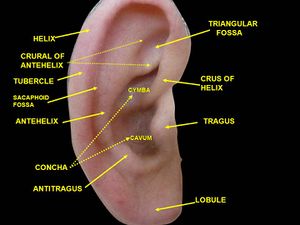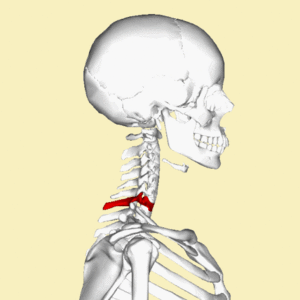Craniovertebral angle: Difference between revisions
mNo edit summary |
No edit summary |
||
| Line 2: | Line 2: | ||
==Introduction== | ==Introduction== | ||
The craniovertebral angle is identified as the intersection of a horizontal line passing through the C7 spinous process and a line joining the midpoint of the tragus of the ear to the skin overlying the C7 spinous process<ref>Wilmarth M, Hilliard T. Measuring head posture via the craniovertebral angle.</ref> | [[File:Trajus.jpeg|right|frameless]] | ||
The craniovertebral angle is identified as the intersection of a horizontal line passing through the [[Vertebra Prominens|C7 spinous process]] and a line joining the midpoint of the [[Tragus to Wall Test|tragus]] of the ear to the skin overlying the C7 spinous process<ref>Wilmarth M, Hilliard T. Measuring head posture via the craniovertebral angle.</ref>. | |||
Craniovertebral angle is also referred to as cervical angle and [[Forward Head Posture|forward head]] angle.<ref name=":0">Sheikhhoseini R, Shahrbanian S, Sayyadi P, O’Sullivan K. Effectiveness of therapeutic exercise on forward head posture: a systematic review and meta-analysis. Journal of manipulative and physiological therapeutics. 2018 Jul 1;41(6):530-9.</ref> | Image 1: Shows Tragus, part of external ear | ||
* Measurement of cranio vertebral angle, (CVA) is one of the common methods in assessing head posture. | |||
* Craniovertebral angle is also referred to as cervical angle and [[Forward Head Posture|forward head]] angle.<ref name=":0">Sheikhhoseini R, Shahrbanian S, Sayyadi P, O’Sullivan K. Effectiveness of therapeutic exercise on forward head posture: a systematic review and meta-analysis. Journal of manipulative and physiological therapeutics. 2018 Jul 1;41(6):530-9.</ref> | |||
== Measuring == | |||
[[File:C7 animation (1).gif|right|frameless]] | |||
Craniovertebral angle is measured by taking 2 lateral photographs of the subject in a relaxed seated position without a back support. Spinous process of C7 and the tragus of ear are marked with a body marker. A horizontal line is drawn passing through C7 making a right angle with the vertical. Then, the angle between the line connecting C7 spinous process with the tragus of the ear and the horizontal line, is measured using eg. Image J Software.<ref>International Journal of Applied Research 2020 Effects of suboccipital muscle energy technique (MET) versus suboccipital release technique (SOR) on craniovertebral angle, cervical range of motion and chronic neck pain in medical students with upper cross syndrome at the end of 6 weeks: A comparative study Available:https://www.allresearchjournal.com/archives/2020/vol6issue7/PartC/6-6-73-486.pdf (accessed 2.11.21)</ref> | |||
Image 2: C7 animation gif | |||
== Clinically Relevant Anatomy == | == Clinically Relevant Anatomy == | ||
Vertebra prominens is the name of the seventh [[Cervical Anatomy|cervical]] vertebra. The most distinctive characteristic of this vertebra is the existence of a long and prominent spinous process which is palpable from the [[skin]] surface, hence the name. The spinous process is thick, nearly horizontal in direction, not bifurcated, but terminating in a tubercle to which the lower end of the [[ligamentum nuchae]] is attached.<ref>Physiopedia [[Vertebra Prominens|Vertebra prominens]] Available: [[Vertebra Prominens]](accessed 2.11.2021)</ref> | |||
== Craniovertebral Angle and Neck Pain == | == Craniovertebral Angle and Neck Pain == | ||
Revision as of 02:19, 2 November 2021
Introduction[edit | edit source]
The craniovertebral angle is identified as the intersection of a horizontal line passing through the C7 spinous process and a line joining the midpoint of the tragus of the ear to the skin overlying the C7 spinous process[1].
Image 1: Shows Tragus, part of external ear
- Measurement of cranio vertebral angle, (CVA) is one of the common methods in assessing head posture.
- Craniovertebral angle is also referred to as cervical angle and forward head angle.[2]
Measuring[edit | edit source]
Craniovertebral angle is measured by taking 2 lateral photographs of the subject in a relaxed seated position without a back support. Spinous process of C7 and the tragus of ear are marked with a body marker. A horizontal line is drawn passing through C7 making a right angle with the vertical. Then, the angle between the line connecting C7 spinous process with the tragus of the ear and the horizontal line, is measured using eg. Image J Software.[3]
Image 2: C7 animation gif
Clinically Relevant Anatomy[edit | edit source]
Vertebra prominens is the name of the seventh cervical vertebra. The most distinctive characteristic of this vertebra is the existence of a long and prominent spinous process which is palpable from the skin surface, hence the name. The spinous process is thick, nearly horizontal in direction, not bifurcated, but terminating in a tubercle to which the lower end of the ligamentum nuchae is attached.[4]
Craniovertebral Angle and Neck Pain[edit | edit source]
Forward head posture is characterized as pathologic when the craniovertebral angle (CVA) is ≥50° (even though such cutoffs lack rigorous validity). The greater the CVA the more the head is forward relative to the neck.[2]
In a study conducted by Kim et al, it was reported that forward head posture measurement according CVA can be used as a significant index in determining the resulting functional disability of the neck.[5]
The CVA angle reliability and validity has been confirmed in previous studies.[6]
References[edit | edit source]
- ↑ Wilmarth M, Hilliard T. Measuring head posture via the craniovertebral angle.
- ↑ 2.0 2.1 Sheikhhoseini R, Shahrbanian S, Sayyadi P, O’Sullivan K. Effectiveness of therapeutic exercise on forward head posture: a systematic review and meta-analysis. Journal of manipulative and physiological therapeutics. 2018 Jul 1;41(6):530-9.
- ↑ International Journal of Applied Research 2020 Effects of suboccipital muscle energy technique (MET) versus suboccipital release technique (SOR) on craniovertebral angle, cervical range of motion and chronic neck pain in medical students with upper cross syndrome at the end of 6 weeks: A comparative study Available:https://www.allresearchjournal.com/archives/2020/vol6issue7/PartC/6-6-73-486.pdf (accessed 2.11.21)
- ↑ Physiopedia Vertebra prominens Available: Vertebra Prominens(accessed 2.11.2021)
- ↑ Kim EK, Kim JS. Correlation between rounded shoulder posture, neck disability indices, and degree of forward head posture. Journal of physical therapy science. 2016;28(10):2929-32.
- ↑ Salahzadeh Z, Maroufi N, Ahmadi A, Behtash H, Razmjoo A, Gohari M, Parnianpour M. Assessment of forward head posture in females: observational and photogrammetry methods. Journal of back and musculoskeletal rehabilitation. 2014 Jan 1;27(2):131-9.








